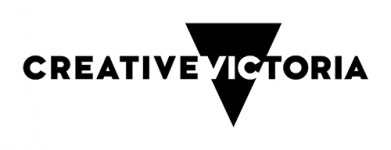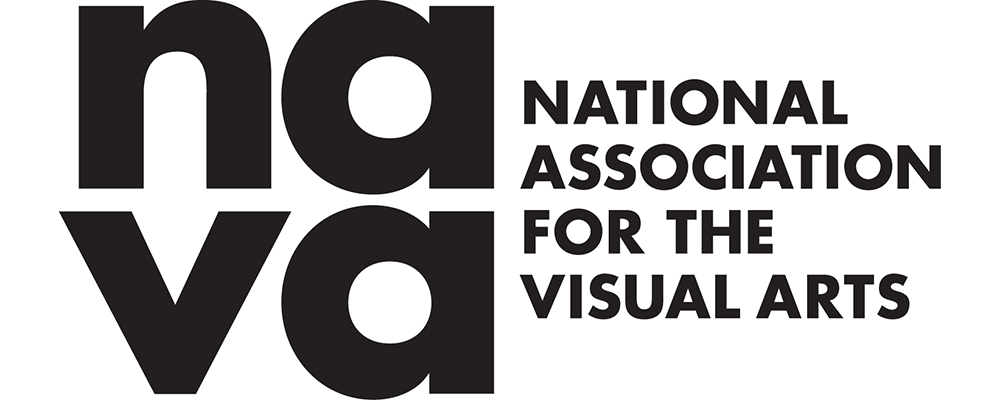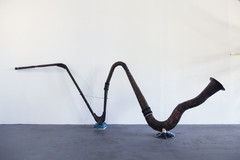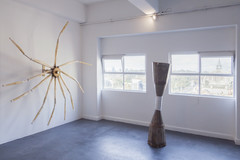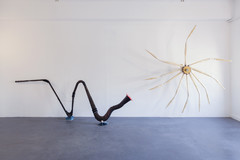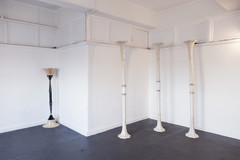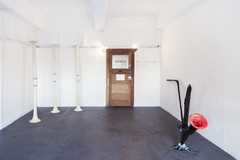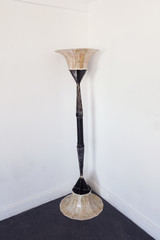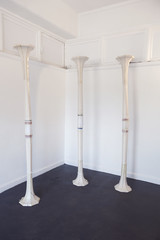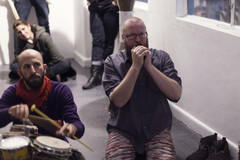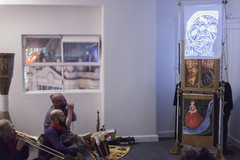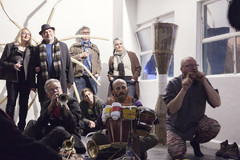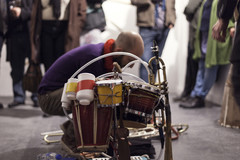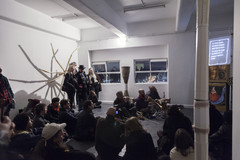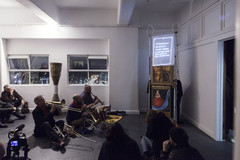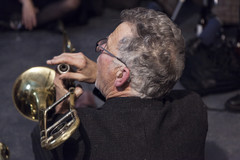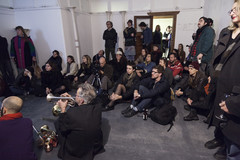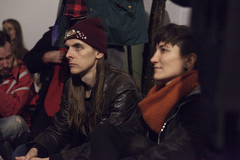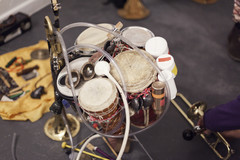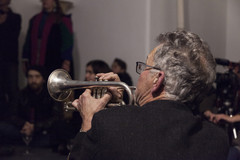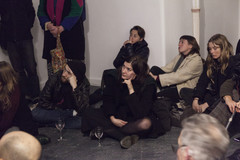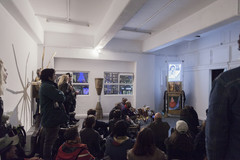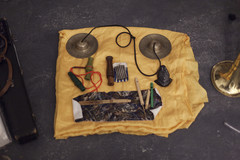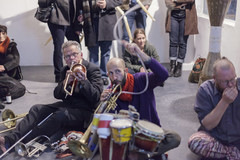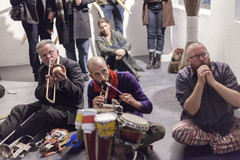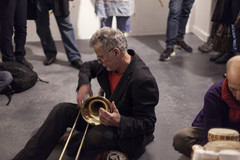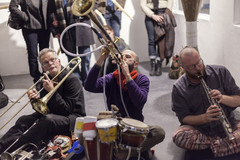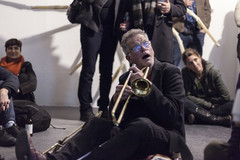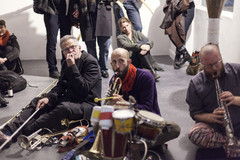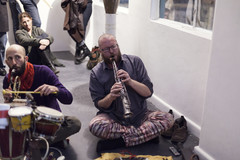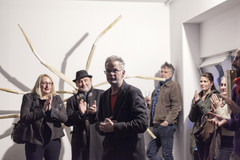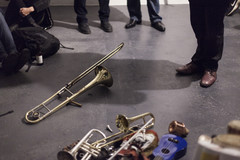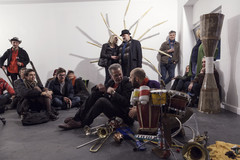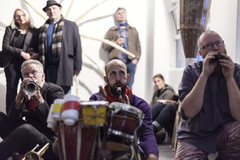Liquid Architecture (LA) is Australia’s leading organisation for artists working with sound and listening. LA is based on Wurundjeri Woi Wurrung Country, at the Collingwood Yards art precinct. Our program sits at the intersection of contemporary art and experimental music, expressed through a range of presentation, publishing, research and commissioning activities.
BACKGROUND
Born in the complex artistic climate of the late 1990s, LA is a millennial imagination of Australia’s vibrant experimental sound culture. Founded in 1999, over the following 15 years, under the direction of Nat Bates, LA grew from being a boutique local event into Australia’s leading festival of experimental, electronic, improvised and avant-garde music.
In 2014, the organisation pivoted with an injection of ideas and resources, and the appointment of Joel Stern and Danni Zuvela as the organisation’s artistic leadership. The duo dissolved the festival model in favour of something more open, unpredictable and experimental: a year-round, curatorial program of boundary-pushing public events, happenings and situations untethered to any one discipline, ideology or format.
Forever expanding and evolving to meet our horizons, the cultural institution we know today as Liquid Architecture is fuelled by the ideas and energies of our team and augmented by the expertise of our board and advisors.
Under the leadership of Kristi Monfries alongside Creative Producer Rohan Rebeiro, Creative Producer James Howard and Programs Coordinator Ronen Jafari, the new direction will expand on this legacy to build strong foundations and relationships with sound experimentations from First Nations, Diasporas, Asia and the Pacific.
Grounded locally but working globally, LA is a dedicated platform for artists engaged in experimental sound practice, sustained and energised through conversation and research, and realised in collaboration with people in our community and beyond.
We acknowledge the Wurundjeri Woi Wurrung as the Traditional Owners and sovereign custodians of the Country on which we practice. We extend our respects to their Elders past and present, and to all First Peoples.
Team
BOARD
DANNY BUTT (CHAIR) is Senior Lecturer in Interdisciplinary Practice at Victorian College of the Arts, University of Melbourne, where he is also Coordinator of Research for Design and Production. His book Artistic Research in the Future Academy was published by Intellect/University of Chicago Press in 2017, and he is on the Editorial Board of the Journal for Artistic Research and is co-convenor of the Asia Pacific Artistic Research Network. As a Certified Management Consultant (CMC) he worked for intergovernmental agencies such as United Nations Development Programme and ASEAN on new media and development and was editor of the book Internet Governance: Asia Pacific Perspectives (Elsevier/UNDP 2006). He works with the Auckland-based art collective Local Time. He moved from Gadigal country in Sydney to Port Chalmers / Koputai, Aotearoa New Zealand in 1993, performing improvised sound and releasing recordings through the 1990s with Peter Stapleton and Kim Pieters in the groups Rain and Flies Inside the Sun (with Brian Crook); with Michael Morley in the Tanaka-Nixon Meeting; and as Cobweb Iris.
REBECA SACCHERO (DEPUTY-CHAIR)
Rebeca Sacchero is a Producer with extensive experience across multiple Metro Melbourne Inner North Local Government Areas. Rebeca understands the local government context whilst also having relationships and experience in small to medium arts orgs. She has been working in the space of community engaged practice and is passionate about creating arts access for under-represented communities. She has a strong track record of successful projects with youth, the LGBTQIA+ community, CALD communities and seniors. She has worked across visual arts, performing arts and digital media, with a range of government and private stakeholders. These include major festivals, local and state Government, ARI’s, schools, community health orgs, and social enterprises. She completed a degree in Art History and Curatorship at Monash University in 2017 and in 2019 was selected for Leadership Victoria’s LGBTQIA+ Leadership program. She also runs her own community building electronic music events in which she has toured international artists, and is a DJ.
MARK NOLEN (TREASURER) is a Certified Practising Accountant with extensive experience in the creative industries sector. He is currently Management Accountant at ACMI, having previously worked in a similar role at Film Victoria. Along the way, he has helped countless singers, actors, and even clowns get their taxes in order – no laughing matter! When not crunching numbers, you can find Mark sitting back with a fine drop of Scotch whisky, soaking up some even finer tunes.
CLAIRE BREDENOORD (SECRETARY) is an education designer and creative producer with experience in non-profit arts organisations, higher education and start-ups. She has a background in socially engaged arts practice and publishing, most often working across disciplines to produce multimodal projects. Most recently, Claire has contributed to the launch of Industri Education, a live music education organisation aiming to provide pathways into industry, as the Operations and Education Lead. A notable achievement has been collaborating with live music industry stakeholders to design new courses in technical production. Claire holds a Juris Doctor and a Master of Arts and Community Practice. She aims to continue developing her diverse skill set and passion for relational community practice to contribute to First Nations peoples’ fight for justice.
MONICA LIM (MEMBER) is a Melbourne-based pianist and composer of classical contemporary and experimental music. Born in Malaysia and then migrating to Australia in her teens, Monica initially practiced as a Tax Consultant for Deloitte Touche Tohmatsu, before pursuing her own interests in business and the arts. She has produced work for theatre, contemporary dance, installations, and film, as well as solo and ensemble instrumental pieces. She is interested in new cross-disciplinary genres and forms as well as combinations of new technology with music. Monica is currently undertaking a PhD at the Faculty of Fine Arts and Music, University of Melbourne in interactive technology, AI and gesture-led composition. Monica is co-founder of Project Eleven, a philanthropic initiative which supports the contemporary arts and serves on the boards of the Melbourne Recital Centre, the Substation as well as the Member’s Council for Musica Viva.
NARETHA WILLIAMS (MEMBER) is an accomplished practitioner in the Australian creative industries sector. An established artist and music producer, she is a seasoned industry professional with extensive experience across a dynamic range of appointments. Naretha has worked with leading Australian companies and First Nations initiatives, flagship festivals and events, has toured internationally and won several awards. Credits include: St Kilda Festival, Bless Your Blak Arts Festival, Australasian World Music Expo, International Symposium on Electronic Art, Yirramboi First Nations Arts Festival, Science Gallery London, Chunky Move, Performance Space New York, The Melba Spiegeltent, Melbourne Town Hall Grand Organ, Sydney Myer Music Bowl, Sydney Dance Company, and Melbourne’s Flash Forward.
GAIL PRIEST (MEMBER) is a sound artist and writer based on Dharug and Gundungurra land (Katoomba, NSW). Her work spans soundtracks for dance, theatre and video, solo electro-acoustic performance as well sound installations for gallery contexts, both solo and in collaboration. She has performed her live compositions and exhibited sound installations nationally and internationally including in Japan, Hong Kong, Germany, France, Norway and the Netherlands. In 2015-16 she was awarded an Emerging & Experimental Arts Fellowship from the Australia Council. She has undertaken numerous radio commissions and releases music on her own label Metal Bitch Recordings as well as Flaming Pines, Endgame Records and room40. She curates events and exhibitions and writes fictively and factually about sound and media art, working for RealTime magazine for over 15 years. She has been on the board of Performance Space (2011-2014), and a peer assessor for the Australia Council. She has just completed a PhD in creative sound theory at UTS. www.gailpriest.net
DAVID CHESWORTH (MEMBER) is an artist and composer, known for his experimental, and at times minimalist music, who has worked with electronics, contemporary ensembles, film, theatre, and experimental opera. Together with Sonia Leber, David has created installation artworks using sound, video, architecture and public participation. Exhibitions include ‘56th Venice Biennale (2015), ‘19th Biennale of Sydney (2014), and Melbourne Now, National Gallery of Victoria, Melbourne (2013-14). Festivals featuring Chesworth’s music and sound works include Ars Electronica; Festival D’Automne de Paris; Bang on a Can Marathon, New York, Biennale of Sydney; Adelaide and Melbourne Festivals; and MONA FOMA. Early in his career he was co-founder of post-punk band Essendon Airport and for five years was coordinator of the Clifton Hill Community Music Centre, Melbourne. David is a Vice-Chancellor’s Postdoctoral Fellow at RMIT University, Melbourne, researching auditory archives.
STAFF
Kristi Monfries (CEO + Director)
Rohan Rebeiro (Senior Creative Producer)
Ronen Jafari (Programs Manager)
James Howard (Creative Producer: First Nations Programming)
Bianca Winataputri (Editor - Disclaimer)
LA ASSOCIATES
Laura McLean and Suvani Suri (Associate Curators - Capture All)
Helen Grogan (Associate Advisor - Liquid Archive)
INTERNS
Maresca Hidayat
Olivia Stephen
Jess Phillips
Contact
We welcome conversation, ideas and feedback at any time.
info@liquidarchitecture.org.au
TW, FB, IG, YT, MX, SC
Journal, Podcast
104/35 Johnston Street
Collingwood VIC 3066
AUSTRALIA
LIQUID ARCHITECTURE
SOUND INC
ABN 73128090237
ASN A0050679K
Privacy Statement
Liquid Architecture (LA) is committed to protecting the privacy and security of personal information obtained and stored about its audience or clientele, including users of this website.
We understand and appreciate that our audience or clientele and users of this website are concerned about their privacy and the confidentiality and security of any information that may be provided to us.
This policy applies when Liquid Architecture determines what information will be collected or disclosed, or how any information will be processed.
We take a broad understanding of what constitutes ‘personal information’. We understand ‘personal information’ to include any information relating to an identified or identifiable natural person. An identifiable natural person is one who can be identified, directly or indirectly, in particular by reference to an identifier such as a name, an identification number, location data, an online identifier or to one or more factors specific to the physical, physiological, genetic, mental, economic, cultural or social identity of that natural person.
Liquid Architecture is bound by the Australian Privacy Principles contained in the Commonwealth Privacy Act and is compliant with the Privacy Amendment (Enhancing Privacy Protection) Act 2012.
We may, from time to time, review and update this Privacy Policy to take account of new laws and technology, changes to Liquid Architecture’s operations and practices and to make sure it remains appropriate to the changing legal environment.
THE TYPES OF PERSONAL INFORMATION LA COLLECTS
The type of information Liquid Architecture collects and holds includes (but is not limited to) personal information, including sensitive information, about:
- Contact information including email address, phone number, names, gender, organisation, role.
- Connection information including linkages and referrals between people.
- Financial information including amounts paid to LA, donated to LA, or received by LA.
- When you visit our website, our server maintains an access log that includes the following information: the visitor’s IP address, the date and time of the visit to the site, the pages accessed and documents downloaded, the previous site visited, and the type of browser used.
- When you visit our website, cookies are stored on your device that provides information to Google Analytics to give us statistical information about our visitors.
HOW PERSONAL INFORMATION IS COLLECTED
LA collects personal information in a variety of different ways depending on the type of contact that is made with the organisation. We collect personal information both from individuals directly and from third parties.
- Subscribing to LA’s newsletter via the website, in-person or other means
- Visiting LA’s website
- Registering for LA’s programs of events (eg. performances, workshops, lectures)
- Purchasing a ticket for LA’s programs of events via a ticketing system
- Making an online enquiry
- Making an individual donation to LA
- Becoming a sponsor
- Submitting a proposal to LA
- Providing written feedback to LA
- Through agreements with programming partners to add addresses to our mailing lists
- Images of persons might be collected during documentation of an LA performance
- If you become a LA Associate, Volunteer or Board Member
LA may also collect personal information over the phone, in person or by electronic correspondence in order to undertake its regular administrative operations
WHY PERSONAL INFORMATION IS COLLECTED
LA collects personal information in order to service the needs of its staff, audience and partnerships. This information is only used with your consent. Your personal information may be retained and used for the following purposes:
- To communicate with staff, artists, associates, volunteers, or Board Members
- For communicating about upcoming programs and services offered by LA and its partners
- For documenting LA performances and events
- To communicate to LA audiences on behalf of other arts or government organisations offering information regarding their products
- For artistic program research and organisational continuous improvement purposes
All details are kept secure at all times and any individual may request their information is not used for direct marketing, research or any other purpose.
DISCLOSURE OF PERSONAL INFORMATION
LA will not sell, lend, disclose, or give personal information of its audience or clientele to external individuals or organisations without first obtaining the customer’s consent.
LA may, however, disclose your personal information or financial data (information exchanged in transactions relating to donations, ticket purchasing or any other product sold):
- To our insurer or legal advisors for the purpose of obtaining insurance coverage, obtaining professional advice, and managing risks.
- To our payment services providers or financial institutions. LA will share transaction data only to the extent necessary for processing, refunding, or dealing with queries about payments.
- In a situation where such disclosure is necessary for compliance with a legal obligation that LA is subject to, or in order to protect the vital interests of a person.
LA will not disclosure personal information to recipients in another jurisdiction unless that jurisdiction has a privacy regime at least as equally protective as Australia. LA will always ask for specific consent before disclosing personal information to a recipient in another jurisdiction.
PERSONAL INFORMATION ACCURACY
LA is committed to ensuring all personal information it collects is accurate, complete and up-to-date. However, the accuracy of this personal information to a large extent depends on the information provided by its clients. LA asks that all clients:
- Advise us if you become aware of any errors in your personal information.
- Advise of any changes in their personal details, such as address, email address and phone number.
YOUR RIGHTS
At any time, any person has the right:
- To know what personal information LA holds about them and how it has been used
- To correct or alter any personal information LA holds about them
- To have the personal information about them erased
- To withdraw consent for the collection, retention, disclosure, use or processing of personal information
- To make a request or inquiry, write to info@liquidarchitecture.org.au
WEBSITE
The LA website contains links to other sites. LA is not responsible for the privacy practices of other sites. LA encourages users when they leave the site to read the privacy statements of each and every web site that collects personal information. This privacy statement applies solely to the activities of LA.
GENERAL DATA PROTECTION REGULATION (GDPR)
LA operates occasional European artistic programming and partnerships, and complies with the data protection policies required by the European Union General Data Protection Regulation (the GDPR) since 25 May 2018.
OUR DATA SECURITY POLICY
LA takes steps to prevent the personal information it holds from misuse, loss, interference or unauthorised access.
LA will also destroy or de-identify personal information when it is no longer needed, or when requested.
ENQUIRIES
If you would like further information about the way Liquid Architecture manages the personal information it holds, please contact LA via info@liquidarchitecture.org.au.
Feedback & Complaints
Liquid Architecture (LA) is committed to respecting feedback and complaints and continually improving our processes. This policy is intended to ensure that we handle complaints fairly, efficiently and effectively. We encourage feedback as part of improving our audience experience and artistic programming.
You can provide feedback or make a complaint via email via email to info@liquidarchitecture.org.au.
HOW DOES LA HANDLE FEEDBACK AND COMPLAINTS?
Upon receiving feedback or a complaint, LA will acknowledge receipt of the feedback or complaint; and request further information if necessary and advise how the issue is likely to be resolved.
LA will not respond to feedback or complaints that violate State or Federal laws, or suggest that others do so; contain profane, violent, abusive, sexually explicit language or hate speech; or are bullying, harassing or disruptive in nature.
Where possible, complaints will be resolved at first contact with us. When appropriate we may offer an explanation or apology to the person making the complaint. Where this is not possible, we may decide to escalate the complaint to LA’s CEOs or Board. Where a person making a complaint is dissatisfied with the outcome of our review of their complaint, they may seek an external review of our decision.
We will take all reasonable steps to ensure that people making complaints are not adversely affected because a complaint has been made by them or on their behalf.
All complaints are confidential. We accept anonymous complaints if there is a compelling reason to do so and will carry out a confidential investigation of the issues raised where there is enough information provided.
HOW LONG WILL IT TAKE FOR MY COMPLAINT TO BE RESOLVED?
The time it takes to resolve a matter depends on the issues raised and any enquiries that need to be made. As a guide, LA aims to acknowledge written feedback and complaints within 1 business day of receipt (if an email address or phone number is provided); respond to all written feedback and complaints within 5 business days of receipt.
LA will consider the matter closed if you indicate that you are satisfied with the response, or LA does not hear from you within 10 business days after sending you its response.
WHAT IF I’M NOT HAPPY WITH THE RESPONSE?
If you are dissatisfied with LA’s response you are encouraged to contact LA to request an internal review. You should outline in writing why you are dissatisfied with the response; and the outcome you are seeking. LA will provide a further response within 10 business days of receiving this information.
If you are dissatisfied with the outcome of our review of their complaint, you may seek an external review of our decision (by the Australian Charities and Not-for-Profits Commission for example).
Australian Charities and
Not-for-Profits Commission
Advice team: 13 22 62
Online Form
TICKET REFUNDS AND EXCHANGES
LA may provide an exchange or refund of a ticket if problems arise before, during or after an event. LA encourages our audience to try to resolve problems as soon as possible after they arise so that we have the best opportunity to find a solution.
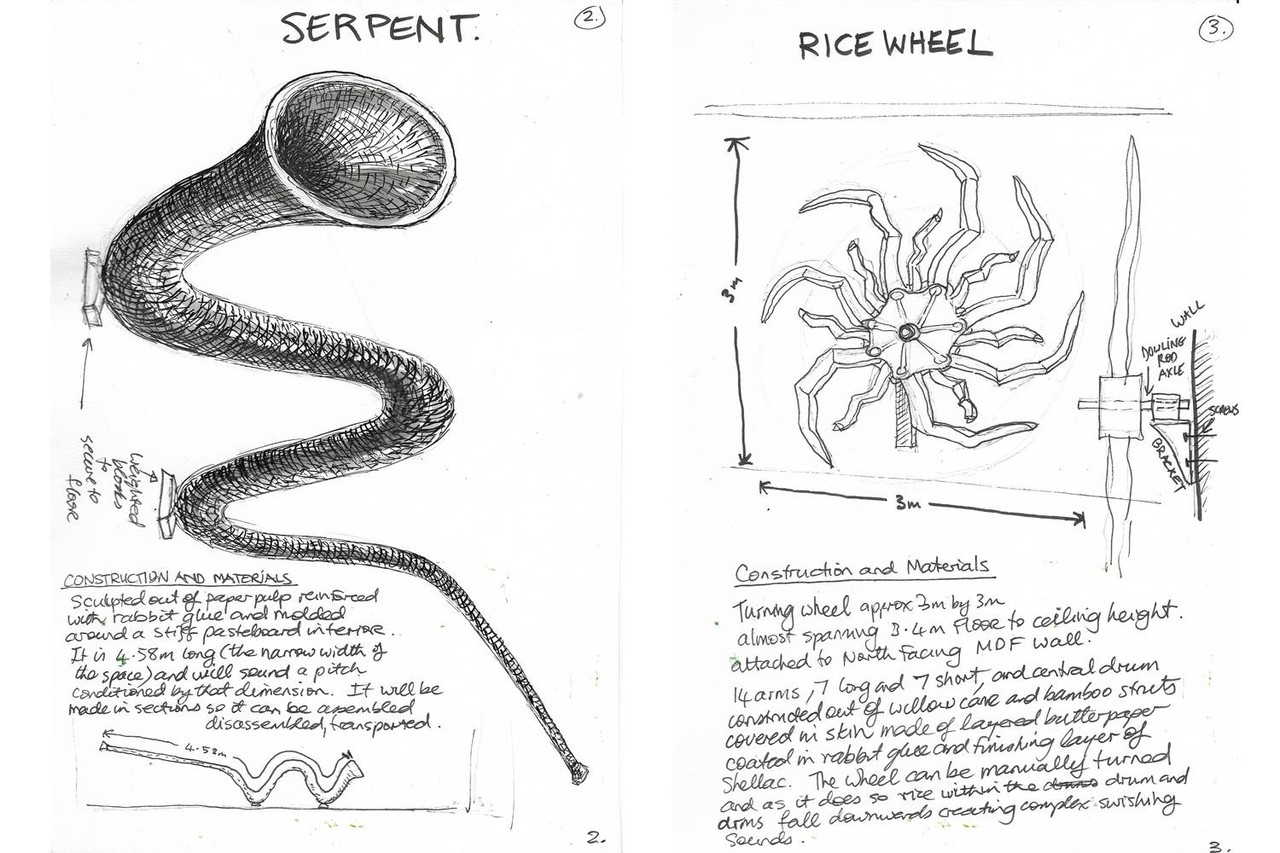
Gerard Crewdson: Serpent Songs / Windshadows
For SOUND SERIES 2018, Gerard Crewdson presents site-specific acoustic sound sculptures. The centrepiece of the exhibition is a natural horn, nearly 5 metres long, made from a single hollow tube (like a didgeridoo) and played with a mouthpiece (like a Swiss alphorn). The horn resembles a ‘serpent’ – not only the creature – but also the instrument of that name which was the predecessor of the modern-day tuba.
Low brass instruments have traditionally been associated with raising the voices of the dead in both Western and non-Western cultures. These are the ‘serpent songs’ of the title but also the ‘windshadows’ – a compound word taken from a Paul Celan poem, Weiss Und Leicht / White and Light. This might be read as a wind of shades, of ghosts, blowing over the genocidal landscape of post WWII Europe. BLINDSIDE stands upon stolen, never ceded Wurundjeri land – a genocidal landscape with its own wind of shades, of ghosts, of voices lost or never heard.
Daily Performances by Gerard Crewdson
4–5PM
Fri. 22, and Sat. 23, June
Tue. 26–Sat. 30, June
Thu. 5, and Fri. 6, July
Closing performance
2–4PM
Sat. 7, July with Anthony Riddell
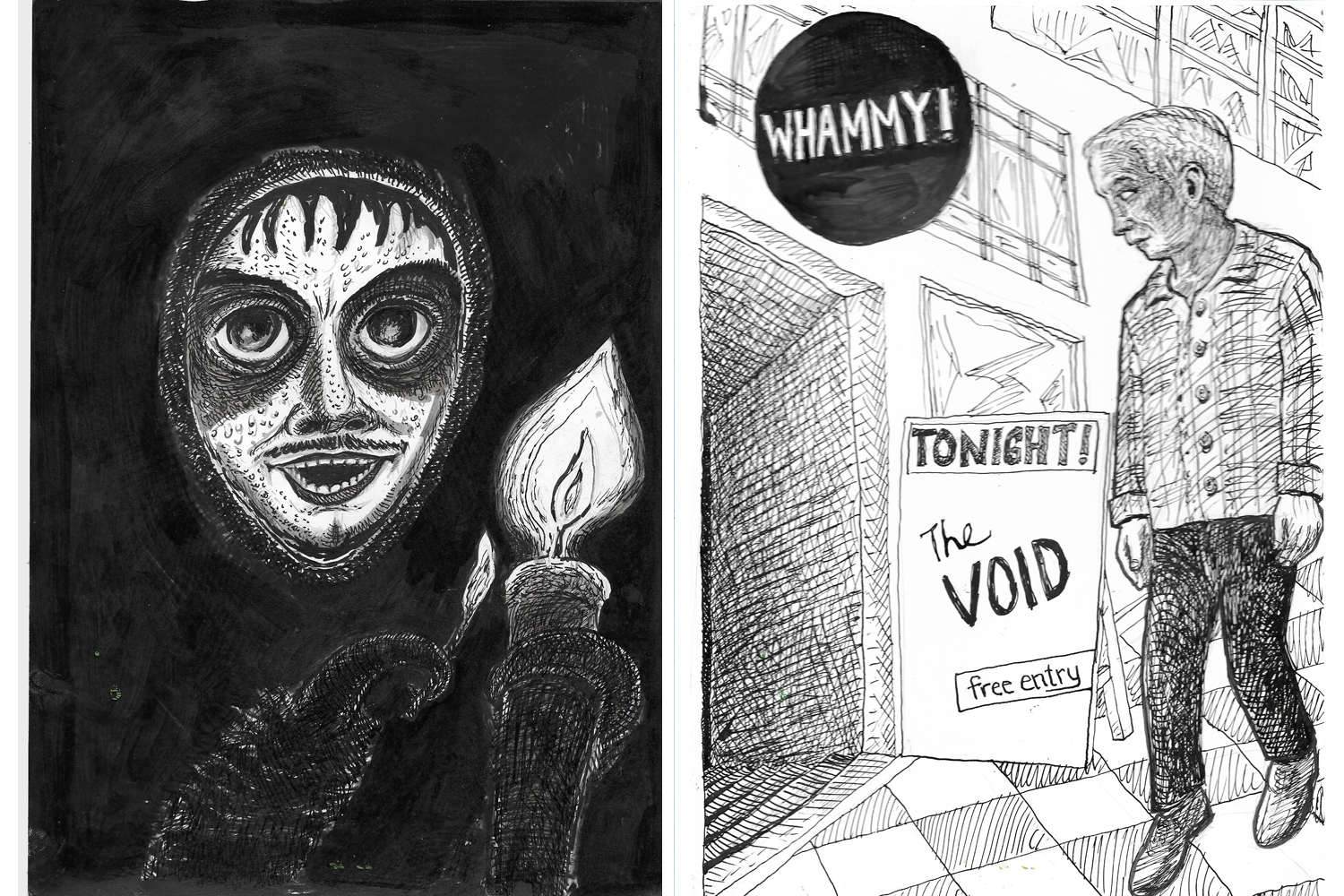
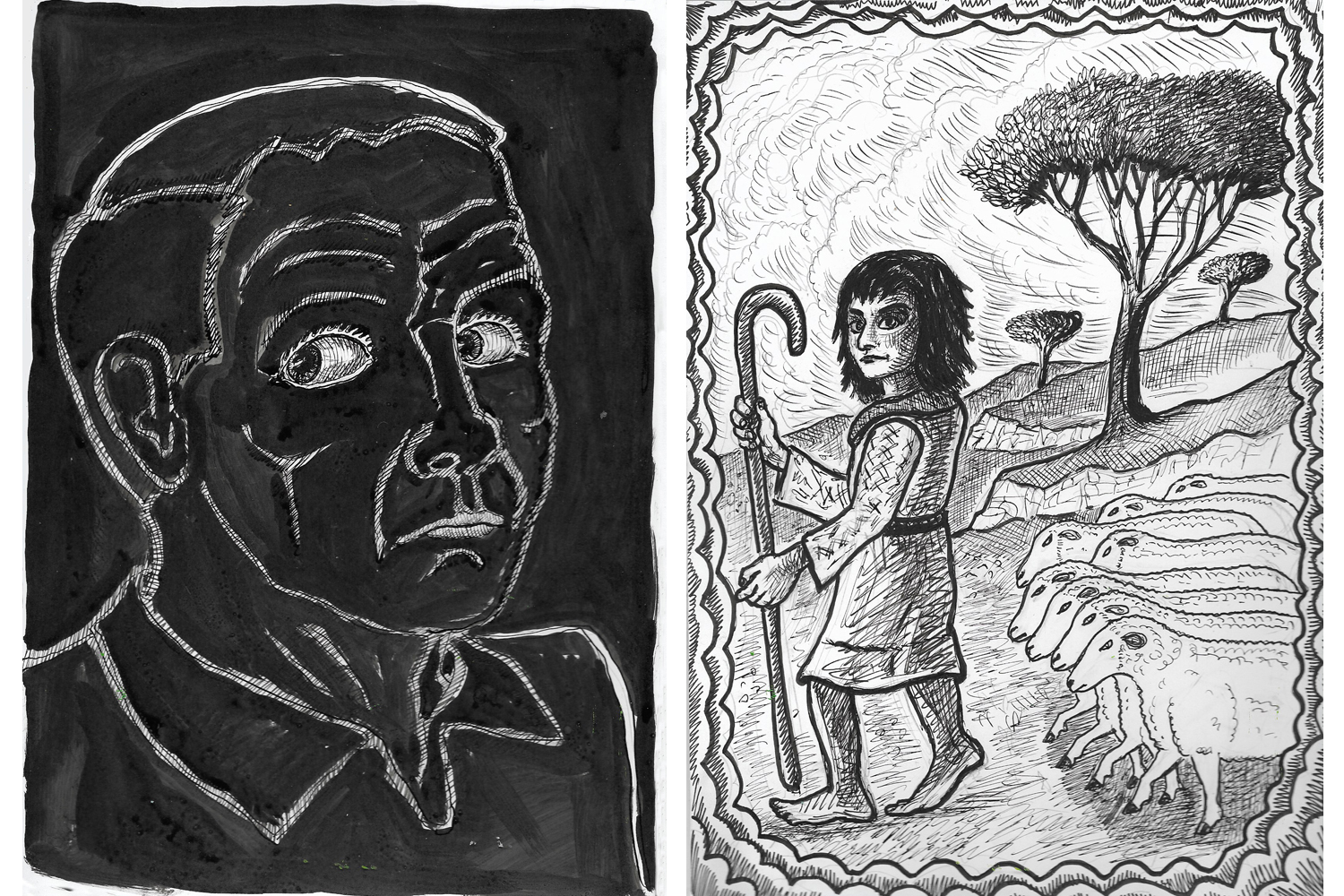
SERPENT SONGS /WIND SHADOWS
From Blindside’s website I have learnt that Melbourne stands upon stolen never ceded Wurundjeri land. This exhibition tries to respond to those words in their full force and meaning. I have read them through the lens of my own relationship with more familiar stolen lands-of the Eora nation in and around Sydney. Each work relates to the ground beneath our feet but begins and ends with silence-the not quite “Cageian” silence that always surrounds us.
The “Galileo Drums” and “Rice Wheel” can be turned to sound with small objects falling to earth either as quantum events or granular cascades. The “Serpent Horn” is difficult to play but is more designed to activate the viewer’s aural imagination so that they might hear lost ghostly voices on the fringe of silence. The “Cinema of Poor” is born from the experience of prolonged and actual poverty upon stolen lands and tells the story of a grave robber with live music. The Galileo Drums and Rice Wheel also link back distantly to a lost world of sound I once knew-the world of sound inhabited by a wheelchair bound blind man living in a government run group home on Sydney’s northern shore.
I was employed to care for Alan and other people with disabilities while completing a degree at Sydney College of the Arts. I continued this work post- graduation. Alan was constantly alert to the tiniest nuance of sound and its different spatial locations. He was always open and curious to experience new sounds but could also hear familiar sounds always in their original freshness. One night Alan was injured while being handled by staff-falling face first to the ground. Because of his intellectual disability he could not say what had happened. The staff reported it as an accident but on subsequent occasions Alan complained to me of being bullied by those same staff. I raised concerns with management about how Alan and the other residents were being mistreated.
The previous year I had been troubled by mysteriously violent dreams-such as a vision of standing at the edge of an abyss and being prodded in the back by a crowd of shadowy faceless strangers.
The dreams were premonitions. Overnight I was barred from my workplace and declared unfit for employment, unless I submitted to a psychiatric examination by a government appointed doctor –a catch 22-for the doctor had been hired to confirm my permanent, incurable unfitness ever to work again.
I refused and was suspended without pay and driven inexorably over the course of a year into destitution and homelessness.
Just before I reached this point, I met Isabel Coe-a lifelong Aboriginal activist and co-founder of the Aboriginal tent embassy. She invited me into a smoking ceremony on the dry earth of a park in Balmain, just off from the main shopping street. She and her people had reoccupied Cockatoo Island in Sydney Harbour. I later attended court as a supporter as they battled my employer- the Crown in the Right of NSW. I remember the instant rage of a supreme court judge when the Aboriginal flag was unfurled along the back wall of the court.
At the same time I was in a grossly uneven fight with the same shape shifting/ accountability-dodging monster and in the same hostile courts. This battle dragged on for eight years of homelessness and poverty during which time I forged an intimate visceral, unmediated relationship with stolen lands of the Eora. Sometimes I slept on the hard surfaces of the CBD –kept awake by the city’s ceaseless hum and street light glare. Other times I would shift to the grassy surface of the parks where the air was fresher but the risks of being beaten up greater . I would closely clutch to my side my most precious possession-a King trombone in its case. My favourite place was near a lonely stretch of beach south of Port Kembla. The skin of my trombone is pockmarked with the air’s salty spray. Towards the end of my ordeal, I was welcomed into a young community of Sydney musicians exploring collaborative improvisation and composition. Their approach to sound and intense listening reminded me of Alan’s sound world of the blind.
This community and parallel communities in Aotearoa /New Zealand were literal life- savers for me.
They helped me survive my ordeal on the stolen lands. Others have not survived. In the abyss on the ground you learn of so many stories of terrible injustice perpetrated by the state- always against the most vulnerable and defenceless. Their voices are the shadow winds that blow across the land-winds of shades, of ghosts. (“Windshadows” from the Paul Celan poem “Weiss und Leicht” /”White and Light” –evoking the haunted genocidal landscape of post war Europe). The serpent horn with its darkened ashen skin invites their voices into this space so that they might have a hearing.
There are people in this land too frightened to look at the ground beneath them. I saw this in Sydney one hot January day in 2009. I had returned to New Zealand and was briefly back in Australia. It was a mid- week lunch hour . Pedestrians teemed along the footpaths. I was dashing to a post office across from the Queen Victoria building. A young Aboriginal woman was sitting on the ground by a pedestrian crossing, quietly at work on a tiny radiant dot painting. There was a cup for donations next to her but it was empty. The crowd flowed past and around her without stopping or even looking down. They had rendered her invisible I placed some coins in her cup. On my return from the from the post office I sat down on the ground beside her. She was as welcoming as Isabel Coe had been under the trees of Balmain. I felt perfectly at home with her as the indifferent world rushed on by above us.
Gerard Crewdson 13/6/18
We acknowledge the Wurundjeri, Boonwurrung, Taungurong, Dja Dja Wurrung and the Wathaurung people of the Kulin Nation as the custodians of the land in which this event takes place, and we recognise that sovereignty was never ceded. We pay our respects to their Elders, past, present and emerging.
Partners


Gerard Crewdson
Exploring non-hierarchical, open-ended, group composition and improvisation…





